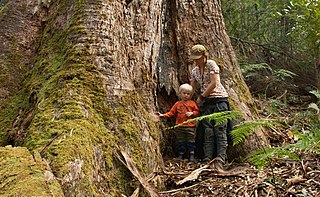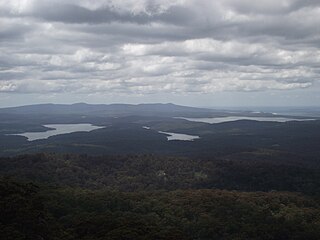Caladenia amoena, commonly known as the charming spider orchid, is a plant in the orchid family, Orchidaceae, and is endemic to Victoria. It is a ground orchid which grows singly or in small groups, has a single dark green, hairy leaf and a single yellowish-green flower with red stripes. It is only known from a few sites and has been classified as Endangered.

Caladenia ampla, commonly known as the dainty spider orchid, is a plant in the orchid family Orchidaceae and is endemic to Victoria. It is a ground orchid with a single hairy leaf and a single flower which is sometimes yellowish-green flower with red stripes and sometimes entirely red.

Caladenia clavescens is a plant in the orchid family Orchidaceae and is endemic to central Victoria in Australia. It is a ground orchid with a single hairy leaf and usually a single dark red to maroon flower.
Caladenia cremna, commonly known as Don's spider orchid, is a plant in the orchid family Orchidaceae and is endemic to a small area in Victoria. It is a rare ground orchid with a single hairy leaf and a single yellow flower with red striations.
Caladenia cretacea, commonly known as Stuart Mill spider orchid, is a plant in the orchid family Orchidaceae and is endemic to a small area in Victoria. It is a rare ground orchid with a single leaf and one or two white flowers on a hairy stalk.
Caladenia dienema, commonly known as the windswept spider-orchid, is a plant in the orchid family Orchidaceae and is endemic to Tasmania. It is a ground orchid with a single, hairy leaf and a single, variably-coloured, usually dark red flower on a thin, wiry stem 5–12 cm (2–5 in) high.
Caladenia flaccida, commonly known as the flaccid spider orchid, is a plant in the orchid family Orchidaceae and is endemic to eastern Australia. It is a ground orchid with a single hairy leaf and up to three cream-coloured, pinkish or red flowers with long, thread-like, glandular tips on the sepals and petals.
Caladenia helvina, commonly known as the summer spider orchid, is a plant in the orchid family Orchidaceae and is endemic to Tasmania. It is a ground orchid with a single hairy leaf and usually a single greenish-yellow to pale yellow flower with reddish teeth on the sides of the labellum and reddish calli along its mid-line.
Caladenia leptochila subsp. dentata, commonly known as the toothed spider orchid, narrow-lipped spider-orchid or narrow-lipped caladenia, is a plant in the orchid family Orchidaceae and is endemic to South Australia. It has a single leaf and one or two mostly reddish-brown flowers. It differs from subspecies leptochila in the colour of its flowers, toothed edges to its labellum, and its distribution.
Caladenia armata is a plant in the orchid family Orchidaceae and is endemic to the Australian Capital Territory. It has a single dull green leaf with purple blotches near the base, and a single cream-coloured to pink flower with red to maroon markings. It is only known from a single population containing fewer than ten plants.
Caladenia branwhitei, commonly known as the Bethungra spider orchid, is a plant in the orchid family Orchidaceae and is endemic to southern New South Wales. It has a single dull green leaf and one or two, usually dark red to maroon-coloured flowers. It is only known from three areas near Bethungra where it grows in ironbark forest.
Caladenia cadyi is a plant in the orchid family Orchidaceae and is endemic to the south coast of New South Wales. It has a single dull green leaf with purple blotches near the base, and a single greenish cream to cream flower with pink to reddish markings. It was only known from a single population which has been bulldozed and replaced with a pine plantation so that it is now probably extinct.
Caladenia douglasiorum is a plant in the orchid family Orchidaceae and is endemic to central Victoria in Australia. It is a ground orchid with a single hairy leaf and a single greenish-cream to yellowish flower with red marks.
Caladenia ensigera is a plant in the orchid family Orchidaceae and is endemic to South Australia. It is a ground orchid with a single leaf and one or two greenish cream to whitish green flowers and is only known from Alligator Gorge in the Mount Remarkable National Park.
Caladenia saxatilis is a plant in the orchid family Orchidaceae and is endemic to South Australia. It is a ground orchid with a single hairy leaf and one or two pale creamy-green flowers, sometimes with thin reddish lines. It occurs in the southern Flinders Ranges.
Caladenia whiteheadii is a plant in the orchid family Orchidaceae and is endemic to New South Wales. It is a ground orchid with a single hairy leaf and a single pale yellow flower with thick reddish tips on the sepals and petals. It is only known from a single hill near Eugowra.
Caladenia flindersica is a plant in the orchid family Orchidaceae and is endemic to South Australia. It is a ground orchid with a single leaf and one or two cream-coloured flowers with thin dark red to blackish tips on the petals and sepals. It is only known from Alligator Gorge in the Mount Remarkable National Park.
Caladenia strigosa is a plant in the orchid family Orchidaceae and is endemic to South Australia. It is a ground orchid with a single leaf and a single greenish-cream flower with fine reddish streaks. It grows in sandy soil in shrubland.
Caladenia zephyra is a plant in the orchid family Orchidaceae and is endemic to South Australia. It is a ground orchid with a single, densely hairy leaf and a single cream-coloured to very pale yellow flower with blackish glandular hairs on the sepals and petals. It occurs on the Eyre Peninsula but may have a wider distribution.
Caladenia fuliginosa is a plant in the orchid family Orchidaceae and is endemic to the Yorke Peninsula in South Australia. It is a ground orchid with a single hairy leaf and a single relatively large, creamy-yellow flower, sometimes with reddish lines. The flowers have a smell resembling hot metal.












